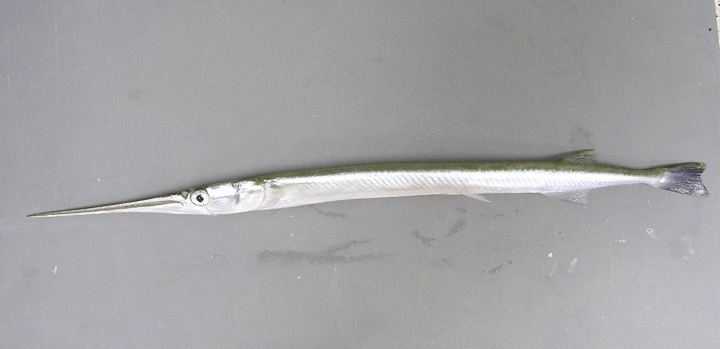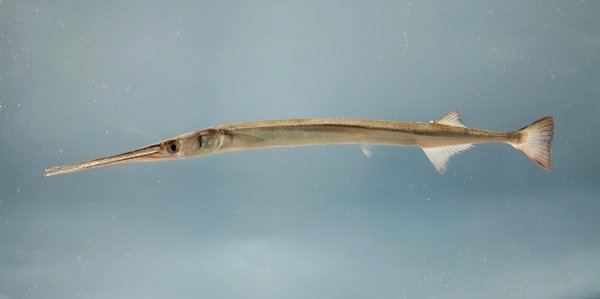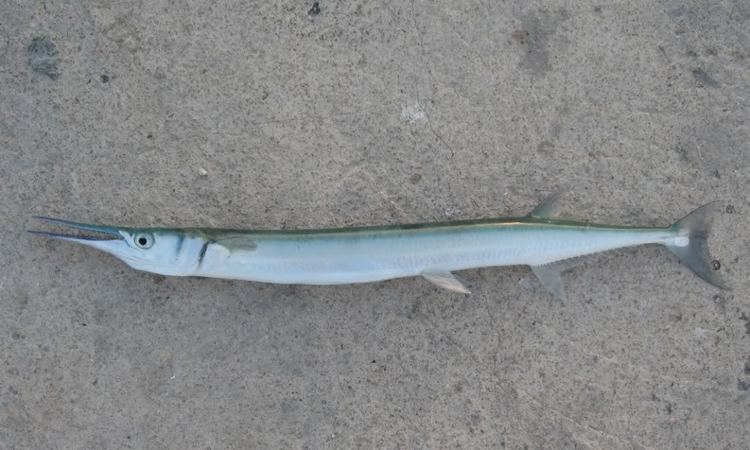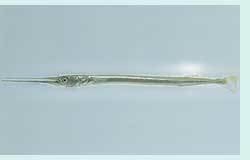Family Belonidae | Phylum Chordata Rank Species | |
 | ||
Similar Strongylura, Inshore lizardfish, Keeltail needlefish, Elops saurus, Eucinostomus | ||
Strongylura marina, known commonly as the Atlantic needlefish, is a common demersal needlefish species common in marinas and other areas with minimal current. Its extremely long jaw and body set this fish apart from other predators. Atlantic needlefish are found from Maine to Brazil and have been known to venture into freshwater for short periods.
Contents

Geographic range

Strongylura marina is found along western Atlantic coastal waters from Maine to southern Brazil, including areas along the coast of the Gulf of Mexico and Caribbean. Atlantic needlefish are not restricted to ocean waters; they can be found in various estuaries and are capable of ascending well upstream into freshwater. S. marina is found in shallow waters throughout the Chesapeake Bay. In Texas, S. marina is known to inhabit the following drainage units: Sabine Lake (including minor coastal drainages west to Galveston Bay), Galveston Bay (including minor coastal drainages west to mouth of Brazos River), Brazos River, Colorado River, San Antonio Bay (including minor coastal drainages west of mouth of Colorado River to mouth of Nueces River), Nueces River. S. marina has also been introduced and now inhabits parts of the Tennessee River drainage throughout Alabama and Tennessee.
Ecology

As juveniles, the diet of S. marina consists of 70% shrimp, mysids and amphipods and 30% fish, while adults are exclusively piscivorous.

The predators of S. marina include larger piscivorous fish such as the Atlantic tarpon (Megalops atlanticus). There are also less common predators that include S. marina in their diet such as the common bottlenose dolphin (Tursiops truncatus) and juvenile lemon sharks (Negaprion brevirostris). Since they are surface swimmers, S. marina are also preyed upon by some birds. The competitors of S. marina include similar sized piscivorous fish species such as bonefish. Although the maximum salinity of Strongylura marina is 36.9 ppt, they are able to adapt to a wide range of salinities, regularly venturing into fresh water.
Life history

Spawning typically occurs in late spring and summer. In Texas, near ripe females have been reported in February. Females lay eggs that have many long filamentous tendrils which attach to floating vegetation or other submerged objects and organisms. S. marina reaches reproductive maturity two years after being born. Spawning activity occurs in shallow inshore habitats with submerged algal masses.
S. marina depends on submerged vegetation for breeding and shelter. In the Gulf of Mexico, the eggs of S. marina attach to sargassum seaweed.
Conservation
S. marina is not currently considered to be a threatened species. It is not of high commercial importance, but there is a fishery for it and it is sometimes taken as bycatch. Sport fishermen take it by angling and seining, and then use it as bait.
Common names
Other common names for the fish include agujon, billfish, bluebone, garfish, green gar, harvest pike, northern needlefish, saltwater gar, sea pike, and silver gar.
